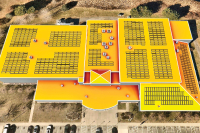Dayco developers want rules relaxed
Developers of a strip shopping complex at the site of the old Dayco factory in Waynesville are asking for several exemptions to the town’s land-use plan, including the height of signs, building appearance and parking lot design.
Home Depot, Wal-Mart and Staples are among the stores rumored to be locating in the complex, but town officials and developers have not confirmed the names of any tenants. About two dozen residents attended a meeting between the developers and the town planning board Monday night (July 17) to hear about the plans. Many in attendance had concerns about the development. Primarily, they want the big box corporate retailers to comply with the same land-use plan others must follow.
The developer, Gary O’Nesti of Cedarwood Development, told the town planning board that the town’s land-use plan simply does work for his style of big box developments.
“The codes are written more toward Main Street development or downtown development as opposed to large-scale or highway commercial development,” O’Nesti said.
Audience members disagreed.
The land-use plan doesn’t rule out big-box stores. It does, however, guard against cookie-cutter big box stores and instead asks corporate developers to blend in with the local community. The land-use plan is intended to make the large-scale highway development O’Nesti is proposing look like a development more in keeping with a small mountain community.
Related Items
“Unfortunately our country has become populated with these eyesores,” said Chuck Dixon, a Waynesville resident. “The good news is our land-use ordinance gives us the ability to control our visual environment. In the mountains, we have got to protect our visual environment.”
Dixon cited Wal-Marts in other parts of the country that have developed stores that fit into the community. Wal-Mart has alternative design plans in its repertoire, including an Adirondack store, a Cape Cod store and a Main Street store.
“Our standards aren’t that unreasonable,” Dixon said. “This is the entrance to Waynesville. Let’s have it look like what we want it to look like.”
O’Nesti continued to insist, however, that the land-use plan was not written with big-box stores in mind. Several audience members were on the citizen’s committee that wrote the land-use plan and they said big box development was indeed part of the discussion when writing the land-use plan. The committee’s hope was that big box stores would design buildings that fit in with the community’s character.
One of the audience members, Philan Medford, passed out a packet with a dozen pictures of big box developments in different towns around the country that were attractive and fit in with the character of the individual community where they were located. Medford’s examples showed developments with courtyards in the parking lots and attractive building facades with windows and awnings rather than long blank walls. Medford said it is possible to design a big box stores that fits in with a community.
“This clearly represents that these developers requests are not necessary,” Medford said of her pictures. “Omitting the requirements for sidewalks and people-friendly facades does not express our community’s values or celebrate our unique sense of place.”
O’Nesti said the pictures Medford shared were indeed nice looking big-box developments, but that is not the project they are proposing. While the plan being presented is a work in progress, it is largely in its final form, O’Nesti said.
“The plans you see is pretty well fixed at this point,” O’Nesti said.
Town planning staff recommend giving O’Nesti about half of the exemptions he is asking for.
“It is what it is. It is a big box store,” said Byron Hickox, the town code enforcer. Hickox said the land-use plan doesn’t accommodate traditional big box design and therefore exceptions are in order.
Hickox nor the town’s lead planner, Paul Benson, worked for the town when the land-use plan was written. Hickox came to Waynesville from Colorado. Benson, the lead planner, does not live in Waynesville but instead commutes to work from Buncombe County. Hickox said there are elements of the town’s land-use plan he and Benson don’t support.
O’Nesti has apparently taken signals from Benson and Hickox as a good sign the town is willing to compromise. In fact, O’Nesti told the audience as much.. O’Nesti said he spent a year working with town planners to reach the current design.
Town staff does not have final say on land-use plan exemptions, however. The final say rests with the town board of aldermen — all five of whom are up for re-election in 2008.
The Brownfield card
The site of the proposed development is known as the old Dayco site, home to a 30-acre rubber factory on South Main Street. The factory closed in 1998 and has been sitting vacant ever since. The site would require significant demolition to get it ready for development. In addition, the site has underground contaminants from chemicals used by the rubber plant.
The contamination qualifies the site as a Brownfield site, a state designation for contaminated sites. The designation is helpful to the developer in insulating them from any legal responsibility due to the contaminants. It also offers tax breaks for redeveloping such a site.
Nonetheless, the site poses a host of problems developers don’t typically face if they had an empty lot or field to work with.
Patrick Bradshaw, a local engineer hired by O’Nesti to help with the plans, said the land-use plan concessions would make the idea of redeveloping a less-than-desirable site “more palatable.” Bradshaw said the cost of complying with the land-use plan is a deterrent to the developers.
Bradshaw said the cost of demolishing the factory was already a huge expense, not to mention the contamination, and as a result the developers needed a break on the land-use plan.
An audience member disputed that notion, however. The developers will get significant state and local tax breaks for the first five years of the development because of its Brownfield status, Roscoe Wells said. Tax breaks in the first year alone will be 90 percent. Those tax breaks will provide all the incentive the developers need.
O’Nesti said the constraints of developing a Brownfield site necessitated the request for variances from the land-use plan.
“We recognize what you are after here,” O’Nesti said of the town’s land-use plan. “What we also want you to recognize is we have a Brownfield’s program with a lot of considerations that go with it.”
Dixon said the public does not have enough information to weigh the validity of O’Nesti’s claim. The public doesn’t know how much the demolition will cost, how much the construction will cost, how much the developers will make or the projected revenue of the corporations that locate here.
“We don’t know if our ordinance is a disincentive to developing this site,” Dixon said. “We don’t know how much they are putting into it and getting out of it.”
Margaret Osondu, the owner of Osondu bookstore, said it is not worth selling out the town’s vision in the long run. Osondu said Waynesville is a growing, desirable community and another developer will come along that wants to invest in the community if this one doesn’t.
“If it is not this one, then it can be another one,” Osondu said. “Someone will want to work with us, and I encourage you not to give up our standards.”
The site has been under contract by O’Nesti for more than two years, making it difficult to know the potential interest in the site by other retail developers. Town staff said they do not know which of the requests are deal breakers if O’Nesti doesn’t get them.
“As far as I know, they haven’t threatened to take their marbles and go home,” said Byron Hickox, a town code enforcer who has been involved in some of the discussion with O’Nesti. “They are saying this is what we want.”
Town Manager Lee Galloway said he also does not know which of the exemptions are deal breakers and whether O’Nesti would walk away from the project if he doesn’t get them. Whether Home Depot and Wal-Mart won’t come to Waynesville unless they can have a 25-foot sign on South Main Street, or whether the idea of attractive building facades is too much for the developers to bear will be hashed out at a work session between the town planning board and town board of aldermen on Aug. 1.









